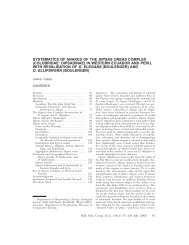cryptic species within the dendrophidion vinitor complex in middle ...
cryptic species within the dendrophidion vinitor complex in middle ...
cryptic species within the dendrophidion vinitor complex in middle ...
You also want an ePaper? Increase the reach of your titles
YUMPU automatically turns print PDFs into web optimized ePapers that Google loves.
SPECIES IN THE DENDROPHIDION VINITOR COMPLEX N Cadle 189<br />
‘‘Peten’’ specimen (MNHN 7353), illustrated<br />
by Lieb (1988: fig. 1), is a syntype<br />
of Herpetodryas poitei Duméril, Bibron,<br />
and Duméril, 1854. See discussion of<br />
historical records under Distribution.<br />
Dendrophidium dendrophis. Dugés, 1892:<br />
100–101 + pl. (Motzorongo [Veracruz],<br />
Mexico). See Smith (1943: 416) and<br />
discussion of historical records under<br />
Distribution here<strong>in</strong>.<br />
Dendrophidion <strong>v<strong>in</strong>itor</strong>. Smith, 1941: 74–75<br />
(type locality: Piedras Negras, Guatemala)<br />
(part; holotype and paratypes from<br />
Guatemala and Mexico). Smith, 1943:<br />
415–416 + fig. 13. Taylor, 1944: 184<br />
(EHT-HMS 27496–98). Smith and Taylor,<br />
1945: 46. Stuart, 1948: 63. Smith and<br />
Taylor, 1950: 318 (holotype). Stuart,<br />
1950: 23. Darl<strong>in</strong>g and Smith, 1954: 191<br />
(UIMNH 33862). Taylor, 1954: 729–730<br />
(part; color description of holotype and<br />
some meristic data quoted from Smith,<br />
1941). Cochran, 1961: 172 (part; holotype<br />
and paratypes, USNM 110662,<br />
7099, 46589). Duellman, 1963: 246.<br />
Stuart, 1963: 94 (part; Mexico and<br />
Guatemala). Peters and Orejas-Miranda,<br />
1970: 79 (part). Alvarez del Toro, 1972:<br />
142, 144. Johnson et al. ‘‘1976’’ [1977]:<br />
134, 136–137. Perez-Higareda, 1978:<br />
69, 72. Alvarez del Toro, 1982: 190–<br />
191. Pérez-Higareda et al., 1987: 16.<br />
Smith, 1987: xxxvii (part; based on<br />
Gün<strong>the</strong>r’s ‘‘Drymobius dendrophis’’).<br />
Flores and Gerez, 1988: 218–219, 261.<br />
Lieb, 1988: 171 (part). Villa et al., 1988:<br />
63 (part). Campbell and Vann<strong>in</strong>i, 1989:<br />
11. Johnson, 1989: 64. Lieb, 1991:<br />
522.1–522.2 (part). Pérez-Higareda and<br />
Smith, 1991: 31, pl. 4. Flores-Villela,<br />
1993: 30. Lee, 1996: 310–311 (Yucatan,<br />
base). Campbell, 1998: 207, fig. 127<br />
(part; specimen from Veracruz, Mexico).<br />
Lee, 2000: 282–283, fig. 315 (part;<br />
Belize). Stafford and Meyer, 2000: 199–<br />
200 (Belize). Savage, 2002: 655–656<br />
(part). Köhler, 2003: 200 (part). Meerman<br />
and Lee, 2003: 67, 70. Stafford, 2003:<br />
111 (part; specimens from Mexico, Guatemala).<br />
Guyer and Donnelly, 2005: 185<br />
(part). McCranie et al., 2006: 147–148<br />
(part). Köhler, 2008: 215 (part). Savage<br />
and Bolaños, 2009: 14 (part). McCranie,<br />
2011: 111 (part).<br />
Holotype (Fig. 1). USNM 110662, from<br />
Piedras Negras [El Petén], Guatemala.<br />
Collected 21 May 1939 by Hobart M. Smith<br />
and Rozella B. Smith (field number 7280) as<br />
part of collections assembled dur<strong>in</strong>g tenure<br />
of <strong>the</strong> Walter Rathbone Bacon Travel<strong>in</strong>g<br />
Scholarship (Smith, 1943: 416). The holotype<br />
is presently <strong>in</strong> fair condition. I did not<br />
exam<strong>in</strong>e it directly but <strong>in</strong>spected dorsal and<br />
ventral photographs provided by USNM<br />
and had selected characters verified by<br />
USNM personnel. Accord<strong>in</strong>g to Smith<br />
(1941), it is a subadult female 510+ mm<br />
total length, 169+ mm <strong>in</strong>complete tail<br />
length (341 mm SVL). The holotype has<br />
several irregular longitud<strong>in</strong>al ventral <strong>in</strong>cisions<br />
from <strong>the</strong> anterior body nearly to <strong>the</strong><br />
vent and on <strong>the</strong> anterior ventral part of <strong>the</strong><br />
tail. The tail tip is miss<strong>in</strong>g. Smith (1941)<br />
described <strong>the</strong> holotype <strong>in</strong> detail, but one<br />
character <strong>in</strong> his description is apparently <strong>in</strong><br />
error: ‘‘n<strong>in</strong>e supralabials, 3rd, 4th and 5th<br />
enter<strong>in</strong>g orbit’’—a character found <strong>in</strong> no<br />
o<strong>the</strong>r specimen (Table 1). Both sides of <strong>the</strong><br />
holotype <strong>in</strong> fact have n<strong>in</strong>e supralabials but it<br />
is <strong>the</strong> 4th, 5th, and 6th that touch <strong>the</strong> eye on<br />
both sides (verified by Steve Gotte, March<br />
2011), which is <strong>the</strong> near-universal condition<br />
<strong>in</strong> <strong>the</strong> specimens I exam<strong>in</strong>ed (Table 1).<br />
Etymology. The specific name <strong>v<strong>in</strong>itor</strong> is a<br />
Lat<strong>in</strong> noun mean<strong>in</strong>g ‘‘v<strong>in</strong>e cultivator’’ or<br />
‘‘v<strong>in</strong>e dresser.’’ Lat<strong>in</strong> lexicons show that <strong>the</strong><br />
word is derived from <strong>the</strong> noun v<strong>in</strong>um<br />
(w<strong>in</strong>e). The complete derivation <strong>the</strong>refore<br />
is <strong>the</strong> stem v<strong>in</strong>- + connective -i- + <strong>the</strong> suffix -<br />
tor. The term<strong>in</strong>ation is a classic noun suffix<br />
mean<strong>in</strong>g an agent or doer of someth<strong>in</strong>g<br />
(v<strong>in</strong>e care and prun<strong>in</strong>g <strong>in</strong> this case). The<br />
name was not a good choice for a forestdwell<strong>in</strong>g<br />
snake.<br />
Hobart Smith gave no etymological <strong>in</strong>formation<br />
<strong>in</strong> <strong>the</strong> orig<strong>in</strong>al description, but<br />
Bullet<strong>in</strong> of <strong>the</strong> Museum of Comparative Zoology harv-160-04-01.3d 11/4/12 19:58:36 189







